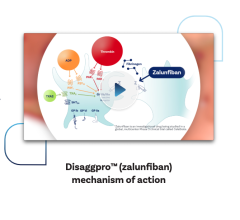
September 25, 2012 — Men and women who undergo joint replacement procedures, as well as those who have significant fractures, tend to be at an increased risk of developing pulmonary emboli (PE), which are blood clots that travel to the lungs where they may cause serious complications and even death. Patients are often aggressively treated with anticoagulants, or blood thinners, to help prevent the clots from forming, but a study published in the September 2012 issue of the Journal of the American Academy of Orthopaedic Surgeons indicates that some blood clots being identified by today's sensitive testing methods may not require aggressive treatments.
"Some recent studies have shown that while the incidence of diagnosis of pulmonary embolism is increasing, there is not a corresponding increase in mortality," said Paul Tornetta, M.D., lead author of the study. "What this suggests is that not all clots have the same clinical relevance—that is, they may not require the same aggressive level of blood thinners for treatment—and that increasingly sensitive tests may be picking up small, relatively insignificant clots that would not necessarily require treatment."
Risks of Treatment
Aggressive treatment of PE typically includes the use of anticoagulants to prevent blood clot propagation. However, orthopedic patients also are at an increased risk for postoperative bleeding, and blood thinner usage can increase that risk.
Accurately identifying blood clots that need treatment, as well as those that are not likely to cause complications, could help physicians reduce patient risks and improve outcomes. Currently though, there are no standard guidelines for differentiating between clots that require treatment and those that do not. "Because these patients are at increased risk for both clot formation and bleeding events, they can pose a unique dilemma which can be very challenging to treat," said Tornetta.
In addition to the increased PE risks associated with some orthopedic procedures or injuries, other factors also can increase a patient's chances of developing one of these conditions, including:
- Older age;
- Use of oral contraceptives;
- Having a personal or family history of PE;
- Undergoing extensive or prolonged surgical procedures; and
- Undergoing a lengthy period of immobilization following surgery or trauma.
Identifying Clots and Diagnosing PE
Many patients with PE have specific symptoms, including:
- Sudden shortness of breath;
- Sudden onset of chest pain;
- Localized chest pain with coughing; and
- Rapid heart beat.
However, many orthopedic patients with potentially dangerous clots do not have symptoms. For these patients, other methods of diagnosis must be used, including blood tests and imaging studies. The most common and popular imaging test is the computed tomography (CT) pulmonary angiogram (CTPA), a very sensitive test that is capable of identifying potentially serious clots that could otherwise go undetected. But because the CTPA is so sensitive, it may also identify much smaller clots that could resolve without use of anticoagulants.
"While it's clear that the use of blood thinners is of paramount importance in treating clinically relevant PE to prevent death, it is also becoming clear that many of these patients may not need the same aggressive level of these medications, which could substantially reduce their risks of bleeding problems," Tornetta said.
Different Approach
While there is no consensus regarding optimal PE treatment, Tornetta said the results of the recent studies indicate that physicians who treat orthopedic surgery and trauma patients may need to use broader criteria when screening for potentially dangerous clots before beginning anticoagulant therapy. Some studies have shown that both the size and the location of the blood clot may be useful in determining whether or not to use blood-thinning drugs.
"Based on current studies, there is no consensus as to what type of treatment, if any, is required when small clots are detected," Tornetta said. "Today's more sensitive detection methods are alerting physicians to small clots that may not require anticoagulant treatment. New guidelines may need to be developed that can help doctors more accurately identify which patients could benefit from anticoagulant therapy and help to balance the risks of aggressive anticoagulation."
Future studies may provide information that can be used to develop guidelines for the treatment of orthopedic patients with small clots. Until then, said Tornetta, as with any drug therapy, patients should discuss the risks and benefits associated with the use of anticoagulants following significant orthopedic injury or surgery.
For more information: www.jaaos.org


 November 19, 2025
November 19, 2025 









